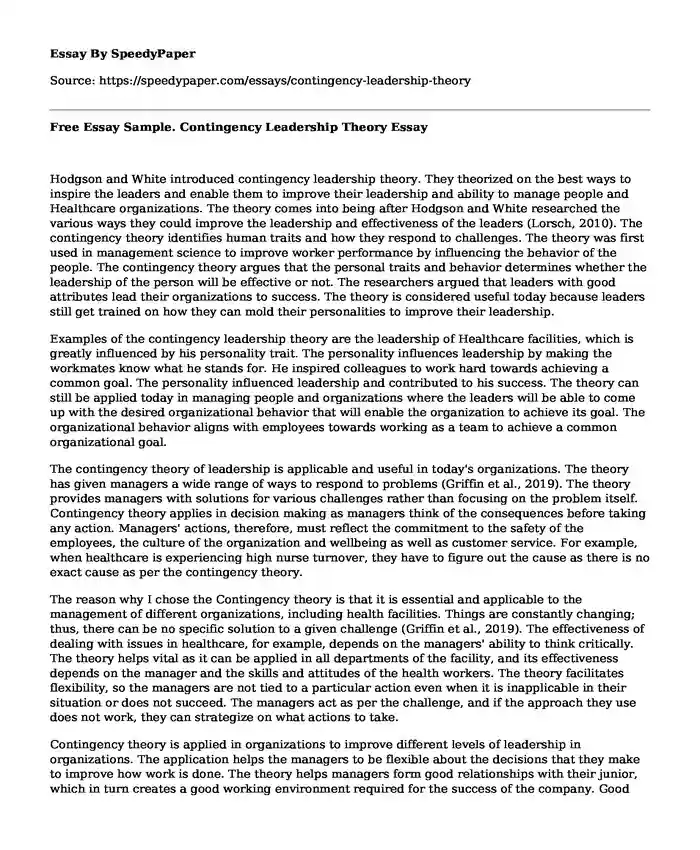
| Type of paper: | Essay |
| Categories: | Organizational behavior Human behavior Leadership development |
| Pages: | 3 |
| Wordcount: | 623 words |
Hodgson and White introduced contingency leadership theory. They theorized on the best ways to inspire the leaders and enable them to improve their leadership and ability to manage people and Healthcare organizations. The theory comes into being after Hodgson and White researched the various ways they could improve the leadership and effectiveness of the leaders (Lorsch, 2010). The contingency theory identifies human traits and how they respond to challenges. The theory was first used in management science to improve worker performance by influencing the behavior of the people. The contingency theory argues that the personal traits and behavior determines whether the leadership of the person will be effective or not. The researchers argued that leaders with good attributes lead their organizations to success. The theory is considered useful today because leaders still get trained on how they can mold their personalities to improve their leadership.
Examples of the contingency leadership theory are the leadership of Healthcare facilities, which is greatly influenced by his personality trait. The personality influences leadership by making the workmates know what he stands for. He inspired colleagues to work hard towards achieving a common goal. The personality influenced leadership and contributed to his success. The theory can still be applied today in managing people and organizations where the leaders will be able to come up with the desired organizational behavior that will enable the organization to achieve its goal. The organizational behavior aligns with employees towards working as a team to achieve a common organizational goal.
The contingency theory of leadership is applicable and useful in today's organizations. The theory has given managers a wide range of ways to respond to problems (Griffin et al., 2019). The theory provides managers with solutions for various challenges rather than focusing on the problem itself. Contingency theory applies in decision making as managers think of the consequences before taking any action. Managers' actions, therefore, must reflect the commitment to the safety of the employees, the culture of the organization and wellbeing as well as customer service. For example, when healthcare is experiencing high nurse turnover, they have to figure out the cause as there is no exact cause as per the contingency theory.
The reason why I chose the Contingency theory is that it is essential and applicable to the management of different organizations, including health facilities. Things are constantly changing; thus, there can be no specific solution to a given challenge (Griffin et al., 2019). The effectiveness of dealing with issues in healthcare, for example, depends on the managers' ability to think critically. The theory helps vital as it can be applied in all departments of the facility, and its effectiveness depends on the manager and the skills and attitudes of the health workers. The theory facilitates flexibility, so the managers are not tied to a particular action even when it is inapplicable in their situation or does not succeed. The managers act as per the challenge, and if the approach they use does not work, they can strategize on what actions to take.
Contingency theory is applied in organizations to improve different levels of leadership in organizations. The application helps the managers to be flexible about the decisions that they make to improve how work is done. The theory helps managers form good relationships with their junior, which in turn creates a good working environment required for the success of the company. Good relations improve the morale of the employees and, in turn, increase their production.
References
Griffin, R., Phillips, J., & Gully, S. (2019). Managing People and Organizations (13th ed.). Cengage. ISBN: 9780357042502.
Lorsch, J. W. (2010). A contingency theory of leadership. Retrieved from https://www.hbs.edu/faculty/Pages/item.aspx?num=37538Porter-O'Grady, T., & Malloch, K. (2014). Quantum Leadership (4th ed.). Jones & Bartlett Learning, LLC.
Cite this page
Free Essay Sample. Contingency Leadership Theory. (2023, Jul 11). Retrieved from https://speedypaper.com/essays/contingency-leadership-theory
Request Removal
If you are the original author of this essay and no longer wish to have it published on the SpeedyPaper website, please click below to request its removal:
- HR Essay Sample: How Datelines Affect Employees' Performance
- Essay Sample on the Topics of Socialization and the Impact of the Media on a Child's Behavior
- Paper Example - Acceptance and Commitment Therapy
- Paper Example: Innovation and Adaptability Portfolio
- The Rights of Women, 1913. Paper Sample
- Essay Sample: Non-Fictional Leader
- Project Management: Successful Leadership Ethics - Essay Example
Popular categories




